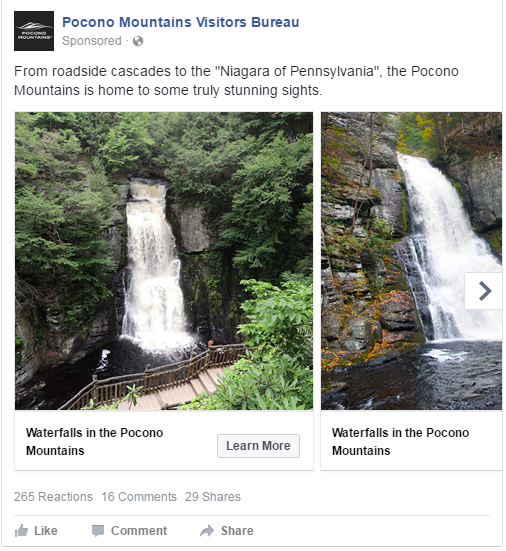Destination marketers get tripped up on attribution.
A tourism board, like the Pocono Mountains Visitors Bureau (PMVB), for example, spans four counties across northeastern Pennsylvania and represents a consortium of hotels, restaurants and activity providers, which makes it difficult to gather real-time metrics on visitation.
“Someone might click on an ad and visit our website, but we can’t see what they do beyond that,” said Brian Bossuyt, PMVB’s director of marketing. “Once they leave the site and go to a member site, we lose the ability to see the true conversion story of what’s driving people into our market.”
Bossuyt joined PMVB roughly two years ago to help the bureau inject digital into its traditional mix of broadcast, out-of-home and print.
The bureau now spends around $700,000 of its roughly $6 million annual marketing budget on paid search and social. Roughly 40% of its overall marketing spend goes to digital.
That’s a lot of scratch to expend without a clear notion of return on investment.
Because travel boards don’t usually have their own booking sites, transactions take place directly with the service providers, cutting the last mile of the customer journey from the bureau’s view.
Tourism boards that want to determine ad effectiveness – whether an ad helped drive a booking – have historically relied on less-than-scientific methods, such as visitor surveys or asking hotels and attractions to share their visitor counts.
PMVB cobbled together a measurement strategy for its digital media campaigns by tracking click-through rate and cost per click.
But that tracking didn’t tell Bossuyt and his team whether the campaign actually resulted in a visit – and it’s difficult to defend budget allocations if you can’t quantify the direct outcome.
State tourism boards are usually funded by public sector money. In Florida, for example, a battle is being waged as to whether to slash the state’s tourism budget. Local stakeholders in the Poconos region were also putting pressure on the visitors bureau to prove that its digital efforts were working.
In early 2016, the PMVB partnered with Arrivalist, an attribution analytics company for destination and travel marketers, to validate that the cash it was spending on digital was doing the job.
The technology is similar to geofencing. Arrivalist places a tracking pixel on the travel marketer’s ads and uses IP address to discern whether the device that saw the ad is the same device that later shows up within a set radius of the destination being advertised. The IP data is validated by GPS data that Arrivalist collects and licenses from its app partners.
“I’ve been in the online travel industry for 20 years and it’s always stood out to me that tourism boards have no real-time ROI metrics,” said Arrivalist’s CEO and founder, Cree Lawson. “The practical joke God played on tourism boards is that they have to sit in rooms full of hoteliers that can measure conversion tracking in real time.”
 Between May 2016 and January 2017, PMVB ran more than 25 million impressions across Google, Bing and Facebook.
Between May 2016 and January 2017, PMVB ran more than 25 million impressions across Google, Bing and Facebook.
Pocono saw ROI upticks across the board, just over fourfold ($4.02) for Facebook, $3.81 for Bing and $2.93 for Google. Arrivalist calculates return on investment by looking at the average revenue per arrival, which is the price of media per media partner, divided by the average revenue that a user is expected to generate.
But beyond bearing the value of its paid digital advertising efforts, Pocono tourism was able to see which CPC channels performed the best. Although Google generated higher click-through rates, Facebook in particular, but also Bing, brought in better performance. For every dollar spent on Facebook ads, for example, the economic return was 37% higher than for every dollar expended on Google paid search.
With those results in mind, the Pocono Mountains Visitors Bureau intends to rejigger its media plan for upcoming CPC campaigns and shift budget to Facebook from anemic marketing channels, including printed collateral.
“Digital is one of the best ways to test a marketing channel and know what people are doing now without waiting for research and numbers to come back about print or TV ads,” Bossuyt said. “We’re getting real-time data to show if advertising is effective, and we’re getting long-term data to show what is successful and what we can do to enhance future campaigns.”












